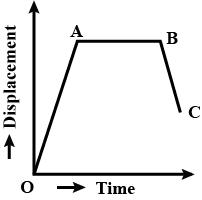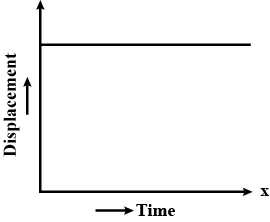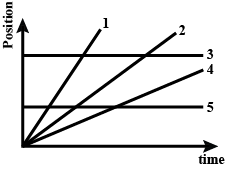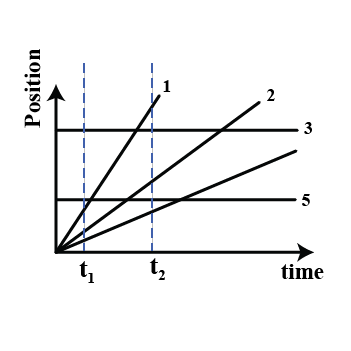Q.1.
A skier starting from rest accelerates down a slope at 1.6 ms−2. How far has he gone at the end of 5 s?
-
25%
20 m
-
38%
40 m
-
25%
15 m
-
12%
60 m
Q.2.
Slope of distance-time graph of a moving body is equal to
-
14%
velocity of the body
-
86%
speed of the body
-
0%
acceleration of the body
-
0%
none of these
Q.3.
In Figure as shown above BC represents a body moving:


-
43%
backward with uniform velocity
-
0%
forward with uniform velocity
-
29%
backward with non-uniform velocity
-
29%
forward with non-uniform velocity
Q.4.
A stone is dropped in the river from a bridge. The stone takes 1 second to touch the water surface in the river. What is the height of the bridge from the water level?
-
0%
9.8 m
-
50%
19.6 m
-
50%
4.9 m
-
0%
1.96 m
Q.5.
The velocity of an object can be changed by
-
0%
changing the speed
-
20%
changing the direction of motion
-
40%
changing both the speed and direction of motion
-
40%
all (a), (b) and (c) are true
Q.6.
A body will have uniform acceleration if its
-
0%
speed changes at uniform rate
-
100%
velocity changes at uniform rate
-
0%
speed changes at non-uniform rate
-
0%
velocity remains constant
Q.7.
The body will speed up if ___________ .
-
67%
Velocity and acceleration are in same direction
-
33%
Velocity and acceleration are in opposite direction
-
0%
Velocity and acceleration are in perpendicular direction
-
0%
None of these
Q.8.
Which one of the following is most probably not a case of uniform circular motion?
-
75%
Motion of a racing car on a circular track
-
25%
Motion of the moon around the earth
-
0%
Motion of a toy train on a circular track
-
0%
Motion of seconds hand on the circular dial of a watch
Q.9.
(a) Find the acceleration of the car
-
25%
2m/s2
-
50%
4m/s2
-
25%
6m/s2
-
0%
8m/s2
Q.10.
The displacement versus time graph shows that the body is moving with constant speed.


-
25%
True
-
75%
False
Q.11.
State whether given statement is True or False.
Speed is the other name of velocity.
Speed is the other name of velocity.
-
0%
True
-
100%
False
Q.12.
Velocity-time graph of a body with uniform velocity is a straight line
-
67%
Parallel to x-axis
-
0%
Parallel to y-axis
-
33%
Inclined to x-axis
-
0%
Inclined to y-axis
Q.13.
A boy is running along the circumference of a stadium with constant speed. Which of the following is changing in this case?
-
33%
Centripetal force acting on the boy
-
0%
Distance covered per unit time
-
67%
Direction in which the boy is running
-
0%
Magnitude of acceleration
Q.14.
In the equation of motion, s=ut+12at2, s stands for
-
100%
displacement in t seconds
-
0%
maximum height reached
-
0%
displacement in the tth second
-
0%
None of these
Q.15.
Distance is a vector quantity. State whether true or false.
-
0%
True
-
100%
False
Q.16.
Area under a speed-time graph gives :
-
0%
The time taken by a moving object
-
100%
The distance travelled by a moving object
-
0%
Tthe acceleration of a moving object
-
0%
Tthe retardation of a moving object
Q.17.
The ratio of SI units to CGS units of retardation is
-
33%
10−2
-
67%
102
-
0%
10
-
0%
10−1
Q.18.
A scooter increases its speed from 36 km/h to 72 km/h in 10 s. What is its acceleration?
-
0%
7.2m/s2
-
100%
1m/s2
-
0%
3.6m/s2
-
0%
10m/s2
Q.19.
What is the velocity of vertically projected body at its maximum height (h)?
-
0%
√2 gh
-
100%
zero
-
0%
h2g
-
0%
√2hg
Q.20.
When the distance an object travels is directly proportional to the time, it is said to travel with
-
67%
Constant speed
-
33%
Zero velocity
-
0%
Constant acceleration
-
0%
Uniform velocity
Q.21.
Retardation means
-
100%
negative acceleration
-
0%
positive acceleration
-
0%
zero acceleration
-
0%
none of these
Q.22.
A body executing non-uniform motion:
-
50%
Undergoes acceleration
-
0%
Never undergoes acceleration
-
50%
May or may not undergo acceleration
-
0%
Never undergoes constant acceleration
Q.23.
The SI unit of acceleration is ms−1.
-
0%
True
-
100%
False
Q.24.
The SI unit of retardation is _____.
-
100%
m/s2
-
0%
m/s
-
0%
m2
-
0%
s2
Q.25.
State whether given statement is True or False.
The rate of change of displacement with time is called speed
The rate of change of displacement with time is called speed
-
0%
True
-
100%
False
Q.26.
SI unit of distance is
-
100%
m
-
0%
cm
-
0%
km
-
0%
none of these
Q.27.
A body suffers retardation of 1ms−2 means
-
0%
its velocity increases by 1ms−1 per second
-
0%
its velocity remains constant
-
100%
its velocity decreases by 1ms−1 per second
-
0%
none of these
Q.28.
Which of the following is not an example of a motion with a constant speed but variable velocity?
-
0%
A car moving at 80kmph on a straight road
-
0%
A car moving at 80kmph on a square track
-
100%
A car moving at 80kmph on a circular track
-
0%
A car moving at 80kmph on a zig-zag path
Q.29.
A body, initially at rest, starts moving with a constant acceleration 2ms−2. Calculate the velocity acquired in 5 s.
-
0%
2ms−1
-
0%
5ms−1
-
0%
7.5ms−1
-
100%
10ms−1
Q.30.
Choose the correct statement:
-
100%
Velocity determines direction of motion of a body
-
0%
Acceleration determines direction of motion of a body
-
0%
Both velocity and acceleration determine direction of motion of a body
-
0%
Neither velocity nor acceleration determine direction of motion of a body
Q.31.
Identify the wrong statement about acceleration.
-
100%
Acceleration is rate of change of velocity per second
-
0%
Acceleration is rate of change of speed per second in a certain direction
-
0%
Acceleration is a vector quantity
-
0%
Unit of acceleration is ms−1
Q.32.
Identify the correct statement:
-
100%
Acceleration increases velocity, retardation decreases it
-
0%
Acceleration decreases velocity, retardation increases it
-
0%
Acceleration and retardation both increase velocity
-
0%
Acceleration and retardation both decrease velocity
Q.33.
Which of the following terms does not go well with the motion of a bus on a crowded road.
-
0%
Uniform velociity
-
100%
Variable velocity
-
0%
Variable acceleration
-
0%
Variable speed
Q.34.
Velocity of a moving body reduces when it undergoes
-
0%
acceleration
-
100%
retardation
-
0%
either acceleration or retardation
-
0%
neither acceleration nor retardation
Q.35.
Direction of motion of a body is given by
-
0%
its speed
-
100%
its velocity
-
0%
both its speed and velocity
-
0%
neither of its speed and velocity
Q.36.
Pick out the wrong statement about retardation.
-
0%
Retardation is negative acceleration
-
0%
Retardation is rate of decrease of velocity with time
-
0%
SI unit of retardation is ms−2
-
100%
Retardation is a scalar quantity
Q.37.
The units of speed and average speed are
-
100%
same across all systems of units
-
0%
same only for SI
-
0%
different across all systems of units
-
0%
different only for SI
Q.38.
When particles move in a circle at a constant speed then the motion is said to be
-
100%
Uniform circular motion
-
0%
Non uniform motion
-
0%
Projectile motion
-
0%
All
Q.39.
Identify in which of the following graphs velocity of the moving object remains constant?
-
0%
-
0%
-
100%
-
0%
-
0%
Q.40.
A jeep is accelerating uniformly in a straight line with 5m/s2. Calculate the time required to cover a distance of 200 m if jeep starts from rest :
-
100%
9.0 s
-
0%
10.5 s
-
0%
12.0 s
-
0%
15.5 s
-
0%
20.0 s
Q.41.
When a body moves in a circular motion :
-
100%
its direction constantly changes
-
0%
its direction remains constant
-
0%
its velocity vector is always perpendicular to the direction of motion
-
0%
all of the above
Q.42.
Which of the following best define the acceleration of a particle:
-
100%
the rate of change of velocity.
-
0%
only experienced during a change of direction.
-
0%
only experienced during a change of speed.
-
0%
calculated by multiplying speed by velocity.
-
0%
always constant.
Q.43.
A car is moving with speed 2 m/s crosses a electric post and starts accelerating at a constant rate of 2 m/s2. How far past the electric post will the car be after 3 s?
-
0%
8m
-
0%
9m
-
0%
12m
-
100%
15m
-
0%
18m
Q.44.
A body is moving vertically upwards. Its velocity changes at a constant rate from 50ms−1 to 20ms−1 in 3s. What is its acceleration?
-
0%
10ms−2
-
100%
−10ms−2
-
0%
1ms−2
-
0%
−1ms−2
Q.45.
A car accelerates at a rate of 5ms−2. Find the increase in its velocity in 2s.
-
100%
10ms−1
-
0%
2.5ms−1
-
0%
5ms−1
-
0%
2ms−1
Q.46.
A car moving with speed 2 m/s crosses an electric post and starts accelerating at a constant rate of 2 m/s2. What will be the speed of the car after 3 s?
-
0%
8 m/s
-
0%
9 m/s
-
0%
12 m/s
-
100%
15 m/s
-
0%
18 m/s
Q.47.
A car moving is with a particular velocity, which has been measured each second and the data is recorded as per the table below.
Velocity Time
0 0
2 m/s 1 s
4 m/s 2 s
6 m/s 3 s
8 m/s 4 s
Calculate the acceleration of the car ?
Velocity Time
0 0
2 m/s 1 s
4 m/s 2 s
6 m/s 3 s
8 m/s 4 s
Calculate the acceleration of the car ?
-
0%
1 m/s2
-
100%
2 m/s2
-
0%
4 m/s2
-
0%
6 m/s2
-
0%
8 m/s2
Q.48.
In which of the following option could represent the ball increasing its speed?
-
100%
-
0%
-
0%
-
0%
-
0%
Q.49.
A car starts from rest and accelerates uniformly over a time of 5.21 seconds for a distance of 110 m. Determine the acceleration of the car.
-
0%
6.10 m s−2
-
100%
8.10 m s−2
-
0%
10.10 m s−2
-
0%
12.10 m s−2
Q.50.
The position-time graphs above represent the motions of cars 1 toHow do they rank according to their speeds (greatest first)?


-
25%
1, 2, 3,4, 5
-
25%
1, 2, 3 and 5 tie, 4
-
50%
1, 2, 4, 3 and 5 tie
-
0%
3 and 5 tie, 4, 2, 1
-
0%
5, 4, 3, 2, 1
